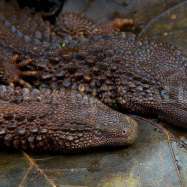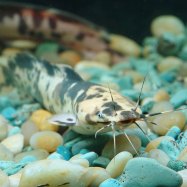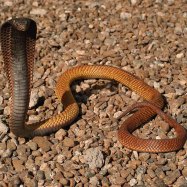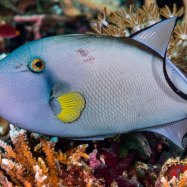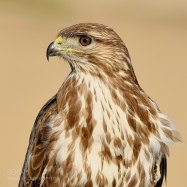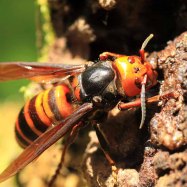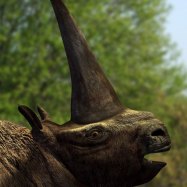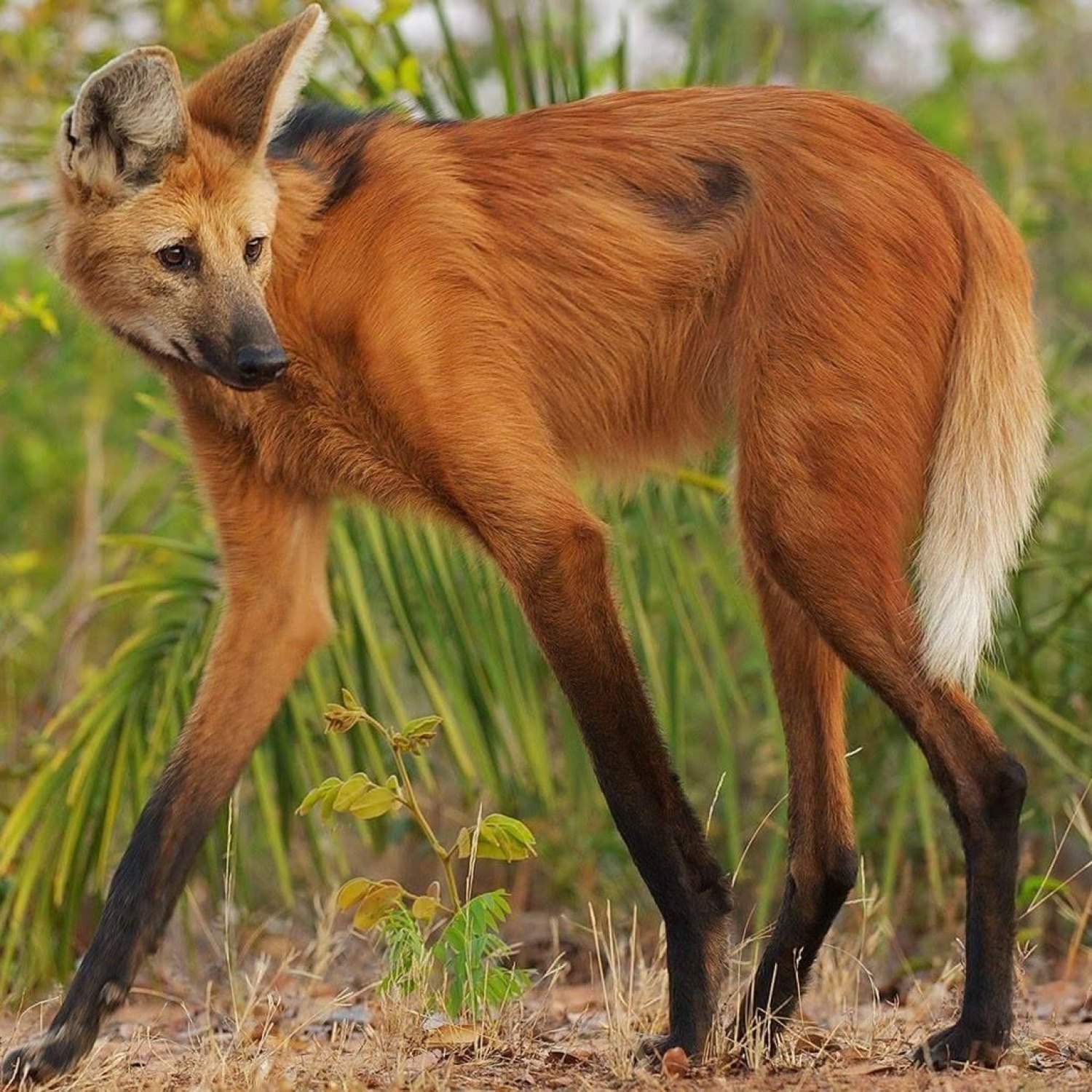
Maned Wolf
100 to 125 cm
The maned wolf, found in the Cerrado and Pantanal regions, is a fascinating animal belonging to the Canidae family. With a height of 100 to 125 cm, this tall and slender creature is often mistaken for a fox or a wolf. But it's unique red fur and long black legs make it stand out. Despite its name, it's not actually a wolf, and is the largest canid in South America. #manedwolf #canidae #wildlife #Cerrado #Pantanal
Animal Details Summary:
Common Name: Maned Wolf
Kingdom: Animalia
Habitat: Grasslands, savannas, and wetlands
The Fascinating Maned Wolf: A Unique Canine of South America
At first glance, the maned wolf may not look like your typical wolf or dog. With its tall, slender body and long, bushy mane, it appears to be a cross between a wolf and a fox. However, this unique animal is a species all on its own, separate from any other canid.Scientifically known as Chrysocyon brachyurus, the maned wolf, or "lobo-guara" as it is known in Brazil, is a member of the Canidae family Maned Wolf. Its name comes from the Greek words chrysos, meaning "golden," and cyon, meaning "dog," and brachyurus, meaning "short-tailed." These names perfectly describe this animal's appearance and characteristics.
Let's take a closer look at the fascinating maned wolf, including its habitat, diet, physical features, and behavior.
Habitat and Distribution
The maned wolf is found primarily in South America, with the majority of its population located in Brazil. Its range extends through Argentina, Bolivia, Paraguay, and Peru, with small populations also found in Uruguay and eastern Colombia. It is estimated that there are currently between 17,000 to 20,000 individuals in the wild.Within Brazil, the maned wolf's habitat is mainly found in the Cerrado and Pantanal regions. These areas are characterized by vast grasslands, savannas, and wetlands, providing the perfect environment for this unique canid to thrive.
Physical Appearance and Adaptations
The maned wolf is a tall and slender animal, standing at around 100 to 125 cm tall and weighing between 20 to 34 kg Mastiff Mix. It is the largest canid in South America, and its physical features have adapted to its specific habitat and lifestyle.One of the most distinctive physical features of the maned wolf is its long, reddish-brown to golden-orange fur. This reddish coloration helps it blend in with the grasses and savannas of its habitat. Its coat is also thicker and longer around its neck, giving it a mane-like appearance, from which it gets its name.
But aside from its fur, the maned wolf also has other adaptations that set it apart from other canids. Its long legs are adapted for running and jumping through tall grasses, and its large ears are uniquely shaped to help it locate prey quickly. These adaptations have made the maned wolf a successful predator in its environment.
Diet and Feeding Habits
Unlike its other canid relatives, the maned wolf has a primarily omnivorous diet. Its main food sources include small mammals, birds, reptiles, and invertebrates. It has also been known to feed on fruits, vegetables, and eggs, making it a versatile and opportunistic feeder.One of the unique feeding habits of the maned wolf is its love for a fruit known as the lobeira. This fruit, which has a distinctly sweet and musky scent, is a staple in their diet and can make up to 50% of their food intake in some seasons. The maned wolf has even been observed rubbing the fruit on its fur, possibly to attract prey with its scent.
Social Behavior and Reproduction
The maned wolf is a solitary animal, except during the breeding season when male and female wolves come together to mate. After a gestation period of around 60 to 65 days, the female gives birth to a litter of 2 to 6 pups, which she raises on her own.While the maned wolf is not a highly social animal, it does communicate through vocalizations. Its loud, high-pitched barks and howls can be heard over long distances, and they are often used to mark territory and attract potential mates.
Conservation Status and Threats
The maned wolf is listed as "Near Threatened" on the International Union for Conservation of Nature (IUCN) Red List. This is due to habitat loss and fragmentation caused by agriculture and urbanization, as well as poaching and roadkill. Additionally, diseases and hybridization with domestic dogs have also posed a threat to the maned wolf's population.Efforts have been made to protect the maned wolf, such as creating protected areas and educating local communities about the importance of conserving this unique species. However, more work needs to be done to ensure their long-term survival.
The Maned Wolf and Human Interactions
Despite being shy and elusive animals, the maned wolf has had a long history of interaction with humans. In Brazil, it is considered a symbol of the Cerrado region, and its image is often used in books, paintings, and even on currency notes. It is also revered in local folklore and traditions.In some areas, the maned wolf is seen as a pest and is hunted for its meat, fur, and body parts, believed to have medicinal properties. However, with conservation efforts and increased awareness, attitudes towards this animal are slowly changing, and it is now mostly protected by law in many parts of its range.
The Importance of Protecting the Maned Wolf
As with any animal, the maned wolf plays a vital role in its ecosystem. As a top predator, it helps control the population of its prey species, maintaining a balance in the food chain. Its role as an omnivore also helps with seed dispersal, contributing to the growth and diversity of plant species in its habitat.But beyond its ecological importance, the maned wolf is also a symbol of the unique biodiversity found in the Cerrado and Pantanal regions. Its conservation is crucial not just for the species itself, but also for the protection of its habitat and the other plants and animals that call it home.
In conclusion, the maned wolf is a fascinating and beautiful animal, both unique in appearance and behavior. Its survival is currently threatened by human activities, but with increased conservation efforts and awareness, we can ensure that this amazing canid continues to roam the grasslands and savannas of South America for generations to come.

Maned Wolf
Animal Details Maned Wolf - Scientific Name: Chrysocyon brachyurus
- Category: Animals M
- Scientific Name: Chrysocyon brachyurus
- Common Name: Maned Wolf
- Kingdom: Animalia
- Phylum: Chordata
- Class: Mammalia
- Order: Carnivora
- Family: Canidae
- Habitat: Grasslands, savannas, and wetlands
- Feeding Method: Omnivorous
- Geographical Distribution: South America
- Country of Origin: Brazil
- Location: Cerrado and Pantanal regions
- Animal Coloration: Reddish-brown to golden-orange
- Body Shape: Tall and slender
- Length: 100 to 125 cm
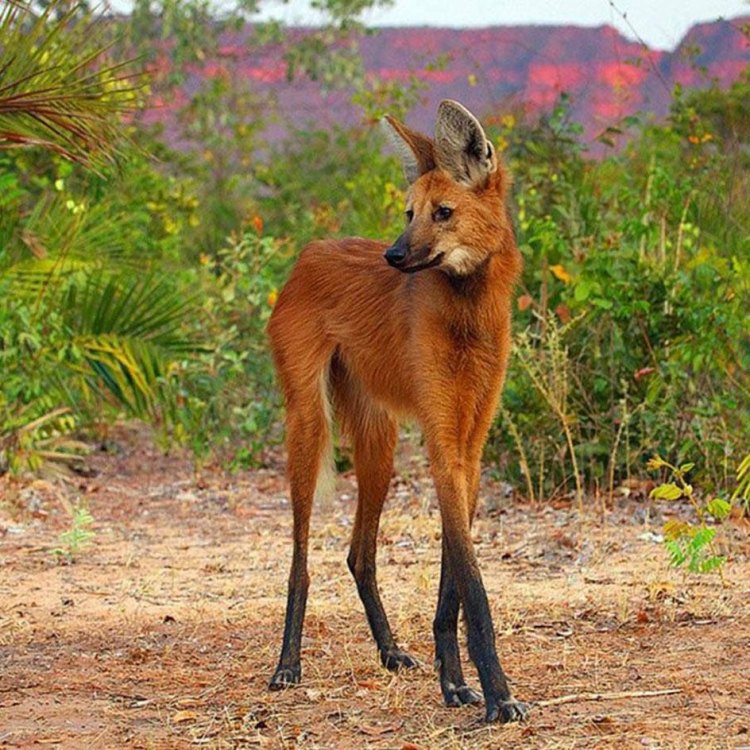
Maned Wolf
- Adult Size: Height at shoulder: 65 to 90 cm
- Average Lifespan: 6 to 12 years
- Reproduction: Monogamous
- Reproductive Behavior: Breeding season: November to February
- Sound or Call: Loud barking or howling
- Migration Pattern: No specific migration pattern
- Social Groups: Solitary or pairs
- Behavior: Most active at dusk and dawn
- Threats: Habitat loss and fragmentation, hunting, and roadkills
- Conservation Status: Near Threatened
- Impact on Ecosystem: Seed dispersal
- Human Use: Some local communities value its pelt and body parts
- Distinctive Features: Long legs, large ears, and a distinct mane
- Interesting Facts: Not closely related to wolves, tallest canid in South America
- Predator: No natural predators
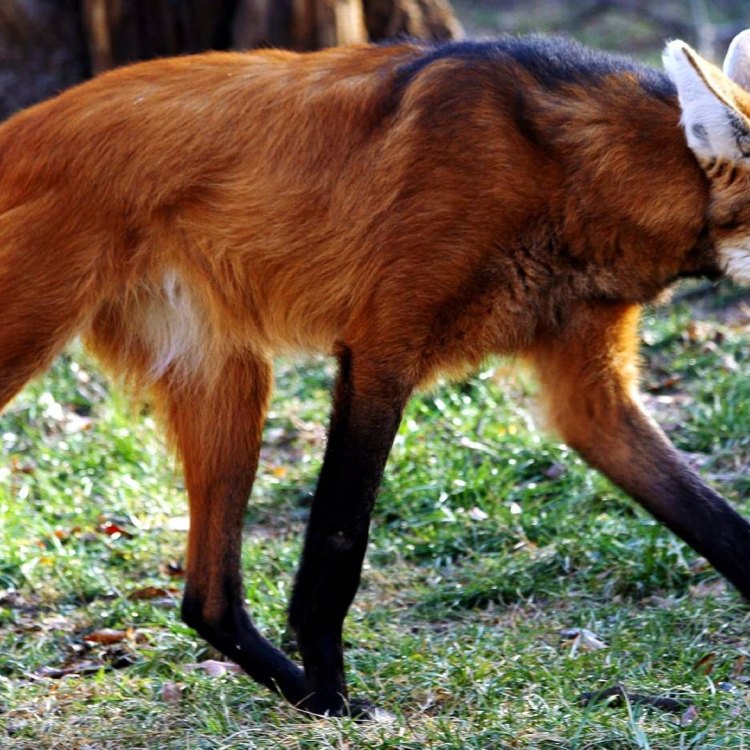
Chrysocyon brachyurus
The Enigmatic Maned Wolf: A Fascinating Canid of South America
In the vast expanse of the South American grasslands, there roams a majestic creature that has captured the curiosity and imagination of many. With its striking appearance and unique behaviors, the maned wolf (Chrysocyon brachyurus) has become a popular subject for wildlife enthusiasts and researchers alike.Known for its distinctive features and solitary nature, the maned wolf is a canid that is often misunderstood and mistaken for its distant relatives, the wolves. In this article, we will delve into the world of the maned wolf and discover its unique characteristics, behaviors, and its vital role in the ecosystem PeaceOfAnimals.Com.
The Physical Traits of the Maned Wolf
Standing at an impressive height of 65 to 90 cm at the shoulder, the maned wolf is the tallest canid in South America. Its long and slender limbs, coupled with its large ears, give it an elegant and graceful appearance. It has a mane of black fur that runs along its neck and shoulders, giving it the name "maned" wolf. This distinctive feature sets it apart from other canids and is used for intimidating rivals or potential predators.The maned wolf's coat is predominantly red, with a white fur around its muzzle, throat, and belly. This unique coloring provides effective camouflage in the grasslands, making it difficult for predators to spot it.
Interestingly, the maned wolf is not closely related to wolves, despite its name and appearance. Its closest relatives are foxes and canids from the genus Canis. This evolutionary divergence is speculated to have occurred due to the geographical separation of the maned wolf from other canids Megamouth Shark.
Biology and Reproductive Behaviors
The maned wolf is a solitary creature, with males and females only coming together during the mating season. They are monogamous and form pairs that remain together for a lifetime. Their breeding season occurs from November to February, with females giving birth to litters of 2 to 5 pups.During this time, the male and female work together to provide for the pups, hunting and caring for them until they are old enough to fend for themselves. This unique parenting style sets the maned wolf apart from other canids, as most canids are known to form packs and have a pack hierarchy.
Their communication is also different from other canids, with their main form of vocalization being loud barking or howling. This is often used to communicate with their mate or to warn off potential threats.
Behaviors and Threats
The maned wolf is primarily a nocturnal animal, with most of its activity occurring at dawn and dusk. They are shy and elusive, making them difficult to observe in the wild. They are also skilled hunters, with their diet consisting of small mammals, birds, and occasional fruits. However, they also play an essential role in the ecosystem through seed dispersal. As they move around the grasslands, they unknowingly spread seeds, promoting plant growth and diversity.Despite their important role in the ecosystem, the maned wolf is facing numerous threats. Habitat loss and fragmentation due to agriculture and urbanization are the biggest threats to their survival. As their natural habitat continues to shrink, they have to compete for resources and are more susceptible to roadkills. Additionally, they are also hunted for their pelt and body parts, which are used in traditional medicine among some local communities.
Conservation Efforts
Due to these threats, the maned wolf is currently listed as near threatened on the IUCN Red List of Threatened Species. However, several conservation efforts are being made to protect this elusive canid. National parks, wildlife reserves, and protected areas have been established to provide a safe haven for the maned wolf. These efforts have yielded positive results, with their population slowly increasing in some areas.Furthermore, public education and awareness about the importance of maned wolves in the ecosystem have also been crucial in conservation efforts. Through these initiatives, local communities are learning to coexist with the maned wolf, reducing the number of conflicts between humans and these animals.
The Future of the Maned Wolf
While there is still much to learn about the maned wolf, one thing is certain – their survival is crucial for the long-term health of South America's grasslands. As top predators, they play a vital role in regulating the balance of the ecosystem, ensuring that it remains healthy and thriving.With continued conservation efforts and the cooperation of local communities, we can hope to see the maned wolf flourish in its natural habitat. However, it is up to us to ensure that this enigmatic canid does not become the next victim of human activities.
In conclusion, the maned wolf is a unique and fascinating creature that deserves our attention and protection. Its distinctive features, behaviors, and important role in the ecosystem make it a valuable part of South America's biodiversity. Let us all work together to ensure that future generations can still have the chance to witness the beauty of the maned wolf in the wild.
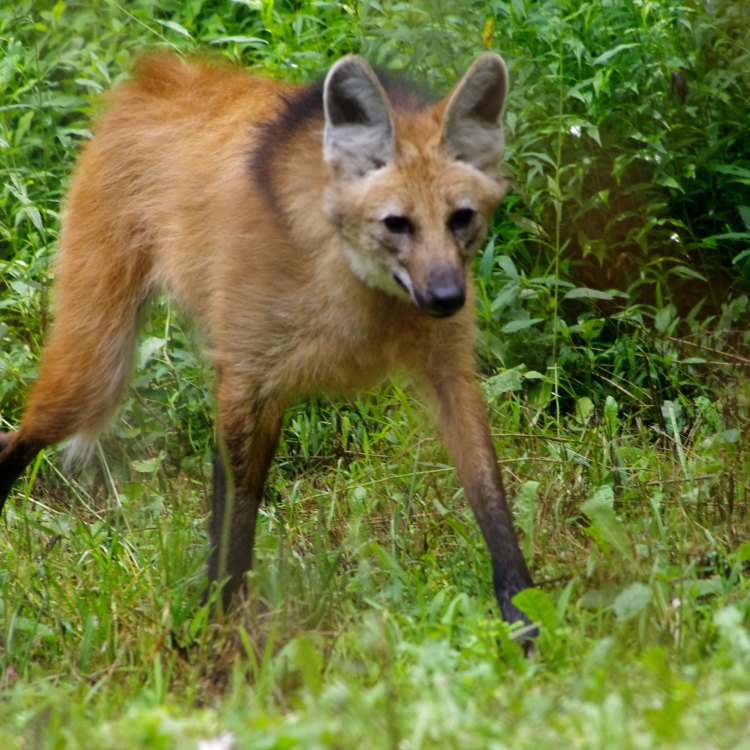
The Fascinating Maned Wolf: A Unique Canine of South America
Disclaimer: The content provided is for informational purposes only. We cannot guarantee the accuracy of the information on this page 100%. All information provided here may change without prior notice.


